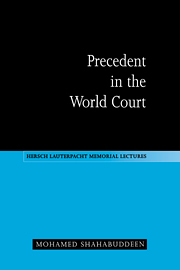Book contents
- Frontmatter
- Contents
- Foreword
- Preface
- List of abbreviations
- 1 Introduction
- 2 The growth of the Court's case law
- 3 Range of precedential resources
- 4 The bases of the system
- 5 The Advisory Committee of Jurists
- 6 The view taken by the League of Nations
- 7 The possibility of judge-made international law
- 8 Stare decisis
- 9 Distinguishing
- 10 Departing from a previous decision
- 11 Ratio decidendi and obiter dictum
- 12 Advisory opinions and decisions of chambers
- 13 The precedential impact of individual opinions
- 14 Effect and scope of the Court's case law
- 15 Conclusion
- Index
7 - The possibility of judge-made international law
Published online by Cambridge University Press: 04 May 2010
- Frontmatter
- Contents
- Foreword
- Preface
- List of abbreviations
- 1 Introduction
- 2 The growth of the Court's case law
- 3 Range of precedential resources
- 4 The bases of the system
- 5 The Advisory Committee of Jurists
- 6 The view taken by the League of Nations
- 7 The possibility of judge-made international law
- 8 Stare decisis
- 9 Distinguishing
- 10 Departing from a previous decision
- 11 Ratio decidendi and obiter dictum
- 12 Advisory opinions and decisions of chambers
- 13 The precedential impact of individual opinions
- 14 Effect and scope of the Court's case law
- 15 Conclusion
- Index
Summary
Introductory remarks
A problem, which has to be acknowledged and which will be returned to later, is this: The adjudicating machinery on the international plane consists of a number of tribunals, some instituted on a bilateral basis, others on a multilateral basis, but with nothing to hold them together in a coherent system. They all make decisions which can influence the development of international law. If that influence can amount to law-making in the case of all of them, the absence of hierarchical authority to impose order is a prescription for conflicting precepts. On the other hand, from the point of view of individual members of the international community, it may not be clear why that influence should amount to law-making in the case of one particular tribunal. It is submitted, however, that there is another point of view from which the matter may be seen, namely, that of the Court itself. The Court can only decide in accordance with international law. How then should the Court itself regard a new principle adopted in a previous case for the solution of a problem presented in that particular case? One cannot of course speak for the Court and can only speculate with hesitation.
- Type
- Chapter
- Information
- Precedent in the World Court , pp. 67 - 96Publisher: Cambridge University PressPrint publication year: 1996

